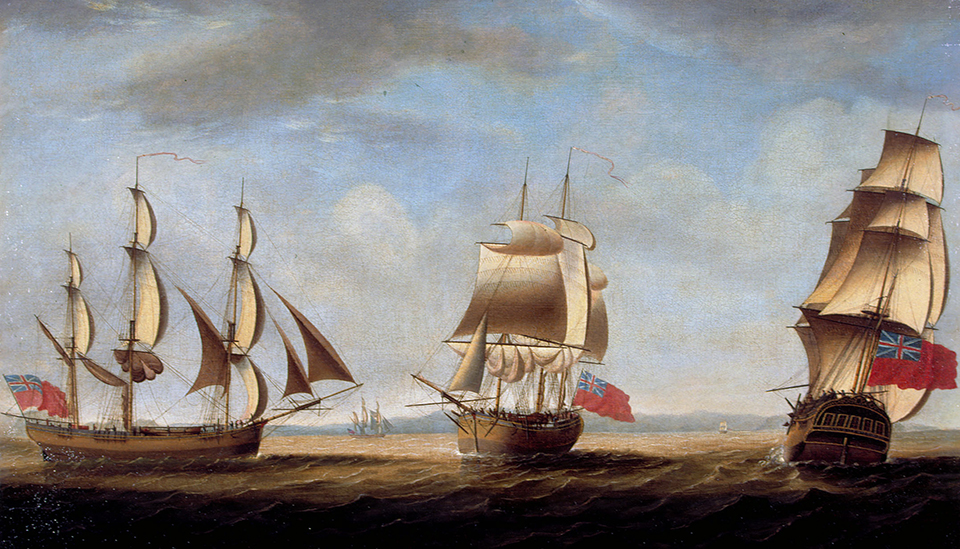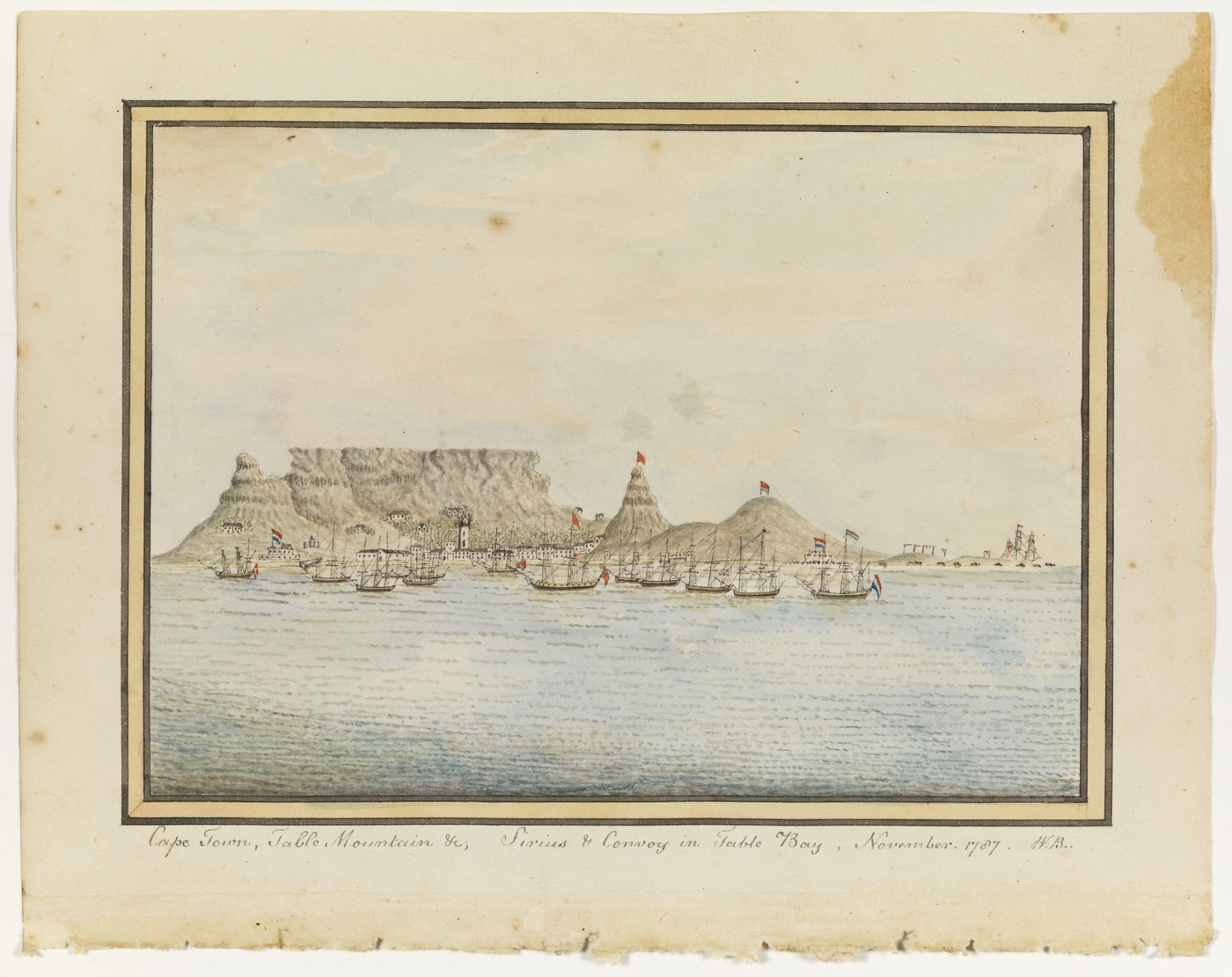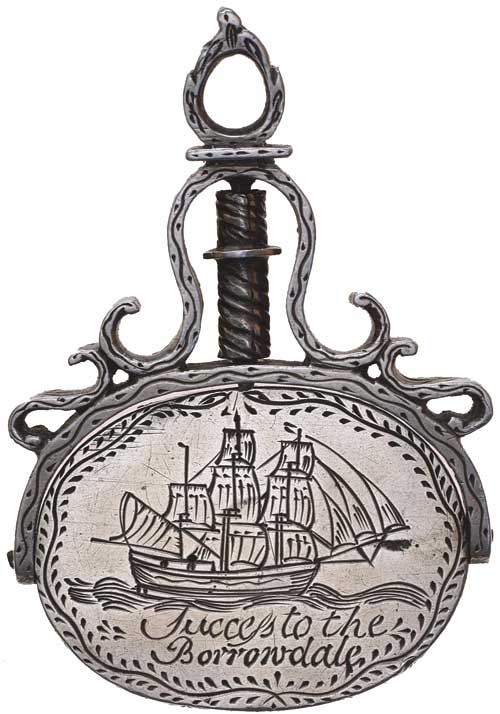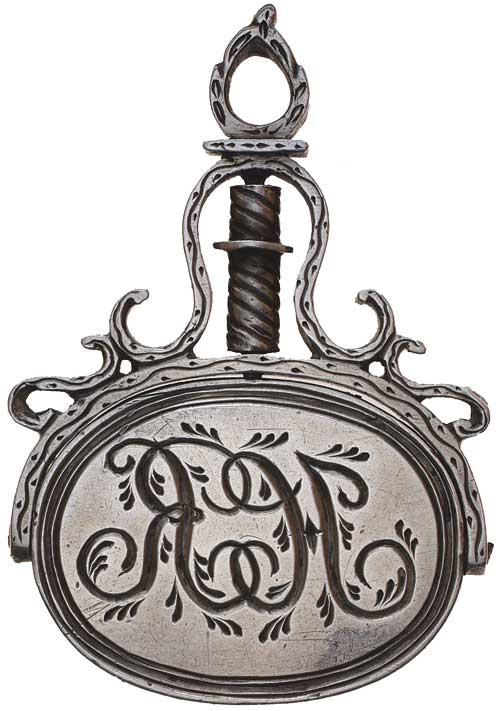The Dictionary of Sydney was archived in 2021.
Borrowdale
Citation
Persistent URL for this entry
To cite this entry in text
To cite this entry in a Wikipedia footnote citation
To cite this entry as a Wikipedia External link
Borrowdale
[media]The three-masted, fully rigged Borrowdale was built in Sunderland in 1785 – a Deptford survey a year later recorded her tonnage as 272, although ship registers at the state declared it to be 320–340 tons. [1] Borrowdale was the youngest of the three storeships of the First Fleet, the others being Fishburn and Golden Grove, all owned by William Leighton & Company, and having been employed in the coal trade. [2]
Borrowdale left Portsmouth, England, on 13 May 1787, under the command of master Hobson Reed and a crew of 17. [3] Prior to leaving, the three storeships took on board two years' worth of provisions and stores for the new colony, including 'implements of husbandry, clothing for the troops and convicts and other necessaries'. [4]
From Portsmouth the fleet sailed to Tenerife and Rio de Janeiro before proceeding to Cape Town, and aside from the loss of a fore topgallant sail, [5] Borrowdale seems to have had little trouble during the voyage.
[media]After departing Cape Town, the First Fleet's final stop before setting out for Australia, Captain Arthur Phillip sailed ahead with the four fastest ships, intending to arrive early and begin preparations for the arrival of the others. Borrowdale stayed with the slower group, which was under the command of John Hunter of HMS Sirius, reaching Botany Bay on Sunday 20 January 1788. On 26 January 1788 the entire fleet anchored in Sydney Cove, Port Jackson. [6]
The journey home
[media]Preparations for Borrowdale's return to England were already underway in earnest by early July 1788 and on 14 July, Borrowdale departed Port Jackson to return to England along with the transports Alexander, Prince of Wales and Friendship. The convoy was under the command of Lieutenant John Shortland, agent for the Transport Department. [7]
Borrowdale and Prince of Wales became separated from Alexander and Friendship in late July, and after some deliberation their masters decided to take the route via Cape Horn. However on 23 August, before rounding Cape Horn, Borrowdale became separated from Prince of Wales. [8]
Some 1300 kilometres south of Rio de Janeiro, Borrowdale's Captain Reed altered his direction to the north-east and despite being the faster ship and initially several days ahead, Borrowdale limped into Rio de Janeiro some three weeks after Prince of Wales. An entry in the log of 20 October indicates that Reed was searching perhaps for the island of Trinidad (at that point uninhabited), possibly in order to gather fresh provisions for those on board suffering from scurvy. [9]
The delay had unfortunate consequences for Borrowdale's crew. By the time it reached Rio de Janeiro's outer harbour on 5 November, Borrowdale was nearly crippled by the presence of scurvy and had lost at least four men to the illness. The remaining crew required the assistance of the harbour master and his men in order to bring their ship to anchor the following day. Borrowdale's arrival is recorded in the log of Prince of Wales where the vessel is described as 'sickly'. Eight men were hospitalised on arrival. [10]
Prince of Wales had arrived at Rio de Janeiro in mid-October in a similarly weakened state, but by 16 December both crews had recovered enough to anchor near the harbour mouth and ready their ships for sea. Borrowdale and Prince of Wales left Rio de Janeiro on Christmas Day, taking different routes but arriving almost simultaneously at Falmouth on 22 March 1789 after a voyage of nine months. [11] Borrowdale and Prince of Wales were the earliest of the First Fleet ships to return to England.
The vessel returned to use as a collier for the coastal trade and sank off Great Yarmouth, Norfolk, during a powerful gale on 31 October 1789, with the loss of Captain Reed and all but one of the crew. [12]
[media]In 1999 the Borrowdale seal was rediscovered in an antique shop in Dorset. The seal is a significant piece of First Fleet history associated with Captain Hobson Reed, master of the ship Borrowdale, one of three supply ships of the First Fleet.
References
Cavanagh, AK. The Return of the First Fleet Ships. Victoria: Australian Association for Maritime History, 1989.
Bateson, Charles. The Convict Ships, 1787–1868. Glasgow: Brown, Son & Ferguson, 1969.
Phillip, Arthur. The Voyage of Governor Phillip to Botany Bay. London: John Stockdale, 1789.
Notes
[1] Mollie Gillen, The Founders of Australia: A Biographical Dictionary of the First Fleet (Sydney: Library of Australian History, 1989), 427
[2] Charles Bateson, The Convict Ships, 1787–1868 (Glasgow: Brown, Son & Ferguson, 1969), 95
[3] Mollie Gillen, The Founders of Australia: A Biographical Dictionary of the First Fleet (Sydney: Library of Australian History, 1989), 427
[4] Arthur Phillip, The Voyage of Governor Phillip to Botany Bay. London: John Stockdale, 1789, University of Sydney Library, Australian Digital Collections / First Fleet and Early Settlement, http://purl.library.usyd.edu.au/setis/id/phivoya, 33
[5] Charles Bateson, The Convict Ships, 1787–1868 (Glasgow: Brown, Son & Ferguson, 1969), 106
[6] David Collins, An Account of the English Colony in New South Wales (Sydney: AH and AW Reed, 1975) section III
[7] AK Cavanagh, The Return of the First Fleet Ships, (Victoria: Australian Association for Maritime History, 1989), 5
[8] AK Cavanagh, The Return of the First Fleet Ships, (Victoria: Australian Association for Maritime History, 1989), 6
[9] AK Cavanagh, The Return of the First Fleet Ships, (Victoria: Australian Association for Maritime History, 1989), 6
[10] AK Cavanagh, The Return of the First Fleet Ships, (Victoria: Australian Association for Maritime History, 1989), 6
[11] AK Cavanagh, The Return of the First Fleet Ships, (Victoria: Australian Association for Maritime History, 1989), 6
[12] 'Borrowdale', First Fleet Fellowship website, http://firstfleetfellowship.org.au/ships/golden-grove/, viewed 9 January 2015






